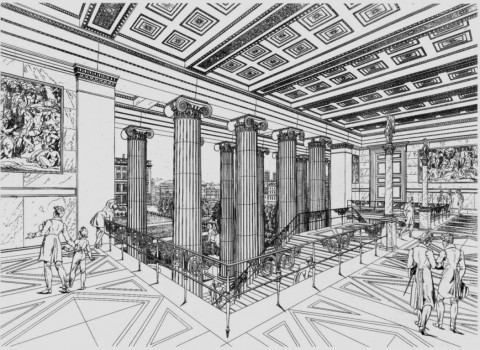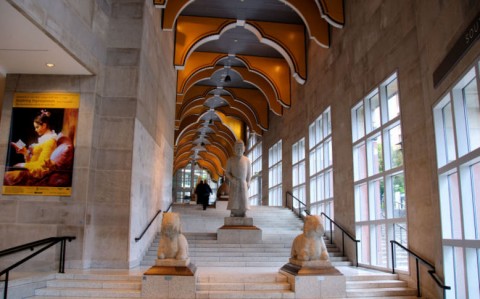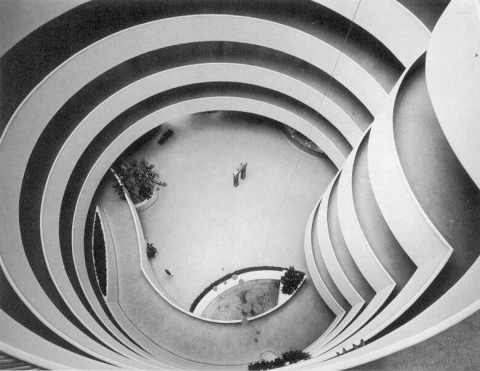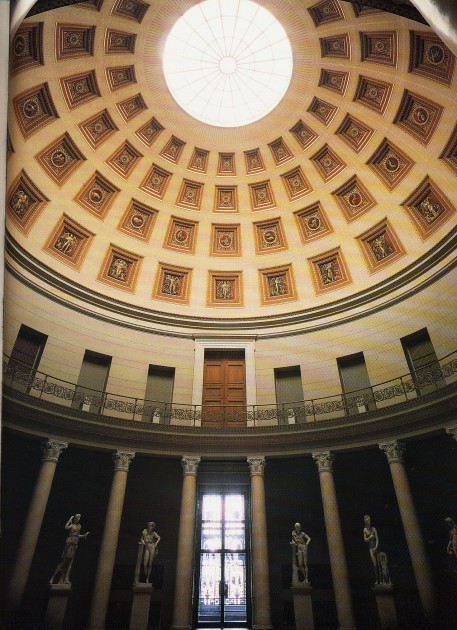Wednesday, May 8th, 2013
Museum “Shrines” and Performative Rituals
The quarter is progressing along, and now I am covering a new book with my students: New Museum Theory and Practice: An Introduction. It’s been really fun to delve into some of the museum theory that I studied several years ago as a graduate student and graduate fellow at a small art museum.
The introduction of this text explores several of the metaphors that are commonly used to describe museums. One of the most interesting metaphors for me is the “museum as shrine.” Museums have a quasi-religious environment, and I like how Janet Marstine explains this idea:
“The museum as shrine is a ritual site influenced by church, palace, and ancient temple architecture. Processional pathways, which may include monumental staircases, dramatic lighting, picturesque views, and ornamental niches, create a performative experience. Art historian Carol Duncan explains, ‘I see the totality of the museum as a stage setting that prompts visitors to enact a performance of some kind, whether or not actual visitors would describe it as such.’ Preziosi adds, ‘all museums stage their collected and preserved relics . . . Museums . . . use theatrical effects to enhance belief in the historicity of the objects they collect.”1
This description immediately made me think of the architecture in several museums which encourage performative, theatrical, and even ritualistic actions from the visitor. The first space that came to mind was the Grand Staircase at the Louvre, above which the “Nike of Samothrace” presides (see photo above). Here are some other spaces which I considered:
The Seattle Art Museum has a “processional way” staircase in the older part of their museum. Although these stairs are no longer used on a regular basis, there are escalators in the main museum area which carry the visitor to higher physical (and suggestively “spiritual”) levels. Even with an escalator (which doesn’t require much physical movement on part of the viewer), I think that this motion still contains an element of performance on the part of the viewer. Also, shrine-like picturesque views are found at the Seattle Art Museum Sculpture Garden; the structure of this building is created largely out of glass walls.
The Centre Pompidou probably has the most famous set of museum escalators. The way that the “tubes” slowly climb with alternating sections of flat and angled lines remind me of the terraces of ziggurats from the ancient Near East.
The ramp in the interior of the Guggenheim is probably one of the best examples of ritualistic art, I think because the viewer is continually aware of his or her ascent in relation to the rest of the museum space. The winding ramp reminds me of spires for religious buildings, even contemporary structures like the Independence Temple for the Community of Christ in Missouri.

Schinkel, View of the staircase (and view overlooking the Pleasure Garden) in the Altes Museum, Berlin (19th century). Image courtesy of Wikipedia
I think that the Rotunda of the Altes Museum evokes this shrine-like setting (and performative nature) not only by evoking classical imagery (this is a small version of the Pantheon), but also creating a stage-like setting for the sculptures, separating them either with niches or columns. The sculptures on the bottom level are also elevated onto stage-like plinths.
Last week, my students and I discussed whether today’s museums should try to bring more self-awareness to their designs and displays, in order to perhaps expose or at least recognize the “shrine-ness” of the institution. We wondered what visitors might think if a museum was blatantly decorated like a shrine (with candles around works of art, offerings scattered in front of displays, etc.). Would viewers feel uncomfortable if they knew they were taking part in a ritual at a museum? What do you think?
What are some of the other shrine-like aspects of museums? Can you think of any museums which encourage some type of “performative” or ritualistic-like activity on part of the viewer? In a general sense, I think that the quiet whispers that are expected in many museums can fit with this idea.
1 Janet Marstine, “Introduction” in New Museum Theory and Practice: An Introdution by Janet Marstine, ed. (Blackwell Publishing, 2006. See also C. Duncan, Civilizing Rituals: Inside Public Art Museums (London and New York: Routledge, 1995), pp. 1-2. See also D. Preziosi and C. Farago, Grasping the World: The Idea of the Museum (Aldershot and Burlington, VT: Ashgate, 2004), p. 13-21.





The National Gallery of Art in Victoria has an enormous water wall in the front entrance. The water streaming down the glass wall looks like a full length curtain in front of a theatre-stage, behind which the performance awaits.
Why would you want to make the shrine-ness more explicit? Would that be more honest in some important way?
“Would viewers feel uncomfortable if they knew they were taking part in a ritual at a museum?”
Hm, I don’t think so. Isn’t that the way people treat sacred buildings that also serve as museums, like cathedrals and temples?
Talking of shrines and relics, a couple of museums include the tombs of their founders: The Dulwich Picture Gallery, London, and the Ackland Art Museum, Chapel Hill. (Anyone know of any other examples?) Legend has it that the Ackland was originally intended to go to Duke University but, since only Dukes were allowed to be buried on the campus, UNC got the museum instead!
Hi Hels! My students and I have been exploring how new museum (postmodern) theories revolve around making a museum “more transparent” in terms of its role as an ideological construct. Some museum practices look for ways to explore the “voice” of the museum and whether that voice should always be authoritative. Other museums want to draw awareness to the fact that they are presenting a “voice” to the audience, even if they still maintain an authoritative tone. Perhaps emphasizing the “shrine-ness” of the museum would help to draw attention to the statements about value within a museum setting?
I can see what you are saying about the water wall and a theatrical curtain. I found one fun picture of the water wall here: http://images.smh.com.au/2013/01/16/3957323/Water-20Wall-20at-20Melbourne-s-20NGV-20130116165700216887-600×400.jpg
Hi heidenkind! You bring up a good point. Perhaps people expect to enter into some type of a ritual or “sacred” experience at a museum, even if they may not conscientiously think about it in those terms. Thanks for your comment!
Hi Ben! I love that you brought up tombs. This is a great connection! I know that the rose garden at the Hillwood Collection (Washington DC) contains the a monument with Marjorie Merriweather Post’s ashes.
This topic also reminds me of the Isabella Stewart Gardner Museum in Boston. Even though Gardner’s tomb is not located on site, Gardner specified in her will that no one could change the collection display from the way that she had arranged it. I have read commentaries discussing how this museum is like an immutable memorial to Isabella and her taste.
Thanks for your comment!
@ Ben: Smithson’s crypt (with body) lies in the Smithsonian Castle in Washington DC. (He died in Italy; the body was subsequently brought here). Here’s a link to an image: http://tinyurl.com/mhaovea
@ Alberti’s WIndow: Love your blog!